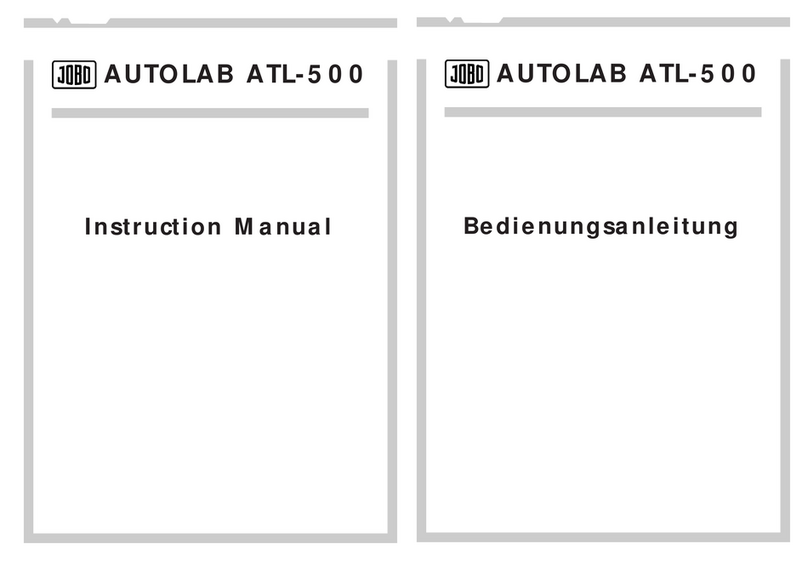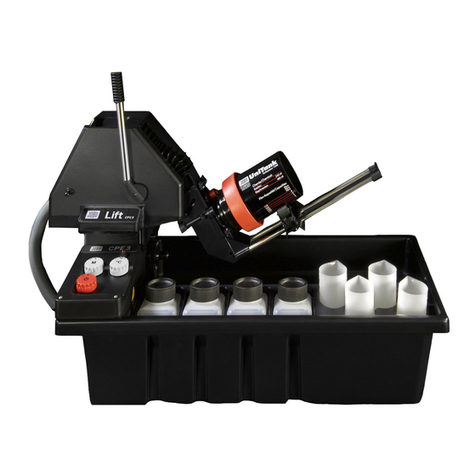
1
Wir stellen vor: Die JOBO ATL's 2200 / 2300 / 2400 / 2500
JOBO - das heißt über 60 Jahre Erfahrung in Papier- und Filmentwicklungstechnologie.
Die Autolabs ATL-2200/2300/2400/2500 sind die neusten freiprogrammierbaren, voll- automatischen Entwicklungsgeräte in
der JOBO ATL Palette. Bei der großen Vielfalt von verfügbaren Tanks und Trommeln ist das Autolab bestens für Arbeiten
verschiedensterGrößenordnungengeeignet.Daesvollkommenbedienerprogrammierbarist,könnenSieEntwicklungszeitenund
-temperaturen für verschiedene Prozesse einspeichern und innerhalb von wenigen Minuten entwicklungsbereit haben.
Alle für die fotografische Entwicklung notwendigen Funktionen, außer der Stabilisierung und Trocknung, sind beim ATL
vollautomatisch.
Die Temperaturregelung des Wassermantelbades arbeitet auf 1/10 Grad genau.
SowohldieFlaschenmitden zuverarbeitendenChemikalien alsauchdie rotierendeTrommelwerden durchdasWassermantelbad
auf Prozeßtemperatur gehalten.
Die Rotationsbewegung sowie der Drehrichtungswechsel werden durch den Mikroprocessor gesteuert. Temperierte Chemikalien
werden mittels eines Druckluftsystems von den
Vorratsbehältern in die Entwicklungstrommel gepumpt. Der eingebaute Computer zeigt, welche Menge an Chemikalien in den
Vorratsbehältern verblieben ist. Folglich läßt Ihr ATL das Starten eines Prozesses nicht zu, wenn nicht genügend Chemikalien
vorrätig sind. Der Mikroprocessor steuert ebenfalls den Zeitablauf jedes Entwicklungs- und Wässerungsschrittes. Außerdem
ermöglicht Ihnen das ATL die Rückgewinnung jeder verbrauchten Lösung, da sämtliche Chemikalien getrennt aufgefangen
werden. Die Rückgewinnung und Wiederaufbereitung verbrauchter Chemikalien macht die Entwicklung mit Ihrem ATL noch
wirtschaftlicher, bzw. ermöglicht eine umweltgerechte, preiswerte Entsorgung.
MERKMALE:
QUALITÄT
· Vollautomatisch durch Mikroprozessorsteuerung
· Konstante Ergebnisse von Prozeß zu Prozeß
· Jeder Prozeßschritt auf die Sekunde genau
WIRTSCHAFTLICHKEIT
· Gute Ausnutzung der Chemikalien
· Automatische Temperaturkontrolle des gesamten Systems
· Eingebaute Chemikalienauffangvorrichtung
VIELSEITIGKEIT
· Direktes Wechseln zwischen verschiedenen Prozessen
· Alle Prozesse sind möglich: z.B. C-41, E-6, Ciba/TM, S/W, R-3, RA-4, Litho, Röntgen
· Jedes Format: z.B. Rollfilm, Kleinbild, Planfilm von 6x9 bis 21x30 cm,
größere Formate auf Anfrage
· Papiergrößen von 7x10 bis 50x60
Wir fertigen Sonderanfertigungen nach Ihren Vorgaben für Filmformate bis 50x60cm, sowie Spiralen für Filmlängen bis 8
Meter und bis 127 mm Breite.
The JOBO ATL's 2200 / 2300 / 2400 / 2500
The AutoLabs ATL 2200/2300/2400 and 2500 are the newest user-programmable, fully automatic developing processors in the
JOBO product line. With the very many tanks and drums available, the Autolab is perfectly suited for a variety of processing
needs. The unit is completely user-programmable, enabling you to programme developing times and temperatures for different
processes, whereby the unit is ready for developing operations within a few minutes.
All functions needed for photographical development, except for stabilizing and drying, are fully automatic in the ATL. The
temperature control system of the water jacket reacts to deviations of 1/10th of a degree. The bottles with the solutions to be
processed as well as the rotating drum are kept at process temperature by the water jacket. The rotary movement is controlled by
the microprocessor. Pre-warmed solutions are pumped from the supply containers into the developing drum by means of a
compressedairsystem. Thebuilt-incomputershows how much solution is left in the storage containers. Consequently, your ATL
will not permit the starting of a process if there is not enough solution. The microprocessor also controls the timing of each
developingand rinsing step. Besides, the ATLpermits you the recovery ofeach used solution, because allchemicals are collected
separately. The recovery and reprocessing of used chemicals makes processing with your ATL even more profitable and permits
a non-polluting, economically priced waste disposal.
FEATURES:
QUALITY
·Fully automatic processing using a sophisticated microprocessor control system
· Consistent results run to run and day to day
· Each process step is accurate to the second
ECONOMIC EFFICIENCY
· Thorough use of chemicals
· Intelligently designed heating system to lower your electric bill
· Chemical recovery for silver reclamation
FLEXIBILITY
· Quickly and easily switch from one process to another
· All common processes are handled: e.g. C-41, E-6, Ciba/TM, B/W, Ilfochrome (Ciba), R 3, RA-4, lithographic, x-ray
· Any format: e.g. roll film, miniature film, sheet film from 6x9 to 21x30 cm, larger formats available on request
· Paper formats from 7x10 to 50x60
We are able to produce special units in accordance with your specifications for film formats up to 50x60 cm, and spirals for
film lengths up to 8 metres and up to 127 mm in width.





























